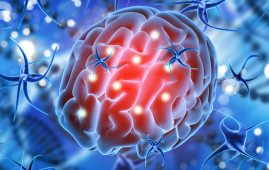

Most neurodegenerative disorders, including dementia, are caused by proteins aggregating into amyloid filaments. Researchers have identified the proteins that aggregate in the majority of these disorders, allowing them to target these proteins for diagnostic testing and treatments.
However, scientists had yet to discover the rogue protein in approximately 10% of cases of frontotemporal dementia. In some situations, scientists have identified aggregated forms of the protein TAF15.
Frontotemporal dementia is caused by degeneration of the brain’s frontal and temporal lobes, which control emotions, personality, and conduct, as well as speech and word understanding. It typically begins at a younger age than Alzheimer’s disease, with most cases identified in persons aged 45 to 65, however it can affect people of any age.
In a paper published in the journal Nature, scientists from the Medical Research Council (MRC) Laboratory of Molecular Biology in Cambridge, UK, identified aggregated structures of a protein that could be used to develop diagnostic tests and treatments in the future.
“This discovery transforms our understanding of the molecular basis of frontotemporal dementia,” stated Dr. Benjamin Ryskeldi-Falcon, who led the study at the MRC Laboratory of Molecular Biology. It is an unusual discovery of a novel member of a tiny group of proteins known to assemble in neurodegenerative illness.
Now that we have identified the key protein and its structure, we can start to target it for the diagnosis and therapy of this type of frontotemporal dementia, similar to strategies already in the pipeline for targeting the aggregates of amyloid-beta and tau proteins that characterize Alzheimer’s disease.”
The researchers studied protein aggregates from the brains of four persons with this kind of frontotemporal dementia at atomic resolution using cutting-edge cryo-electron microscopy (cryo-EM). Tammaryn Lashley of the University College London Queen Square Institute of Neurology and Bernardino Ghetti of the Indiana University School of Medicine recognized the donated brains.
Based on similarities with other neurodegenerative illnesses, scientists have long suspected that a protein called FUS accumulated in this type of dementia.
The researchers at the MRC Laboratory of Molecular Biology were able to determine that the protein aggregates from each brain had the same atomic structure using cryo-EM. Surprisingly, the protein in question was not FUS, but rather TAF15.
Dr. Stephan Tetter, first author on the publication and also from the MRC Laboratory of Molecular Biology, stated, “This is an unexpected result because, prior to this study, TAF15 was not known to form amyloid filaments in neurodegenerative diseases and no structures of the protein existed.” Cryo-EM is altering our understanding of the molecular pathogenesis of dementia and neurodegenerative illnesses in general by providing insights that prior technologies could not.”
“The technical challenge of performing cryo-EM meant that we were only able to look at the brains of four individuals,” Dr. Ryskeldi-Falcon stated. However, given that we know the important protein and its structure, we can create methods to screen for these abnormal protein aggregates in hundreds of patient samples to see how common they are.”
Motor neuron disease and frontotemporal dementia
Some persons with frontotemporal dementia also have motor neuron disease, a disorder in which people gradually lose muscle control. Two of the people who donated their brains in this study displayed symptoms of both disorders. The researchers discovered the same aggregated structure of TAF15 in brain areas linked with motor neuron dysfunction in these individuals.
“The presence of the same TAF15 aggregates in two individuals who had frontotemporal dementia and signs of motor neuron disease raises the possibility that TAF15 may contribute to both diseases,” Dr. Ryskeldi-Falcon said. We are now investigating if abnormal aggregated TAF15 is prevalent in persons with motor neuron disease who do not have frontotemporal dementia.”
“Decades of world-leading research at the MRC Laboratory of Molecular Biology brought the breakthrough of cryoelectron microscopy—earning Dr. Richard Henderson a Nobel Prize in 2017.” said Dr. Charlotte Durkin, Head of the Medical Research Council’s Molecular and Cellular Medicine Board.
“This latest study, which identified the protein linked to a type of frontotemporal dementia, builds on the MRC LMB’s success in elucidating dementia-related protein structures using cryoEM, which includes the first structure for the key dementia protein tau.” The identity and basic structure of these filaments in this rare kind of early-onset dementia are critical for developing early diagnostic tests and medications to counteract their production.”
more recommended stories
 Brain Pulsations Linked to High BMI
Brain Pulsations Linked to High BMIAccording to a new study from.
 Brain Age Estimation: EEG Advancements in Neurology
Brain Age Estimation: EEG Advancements in NeurologyTo estimate brain age using EEG.
 Unlocking Ketogenic Diet for Epilepsy Management
Unlocking Ketogenic Diet for Epilepsy ManagementExploring the Therapeutic Potential of Ketogenic.
 Senescence in Neurons: Findings
Senescence in Neurons: FindingsBased on a new study by.
 Balanced Diet Linked to Enhanced Brain Health
Balanced Diet Linked to Enhanced Brain HealthDiet and brain health are strongly.
 Acid-Reducing Drugs Linked to Higher Migraine Risk
Acid-Reducing Drugs Linked to Higher Migraine RiskIndividuals who utilize acid-reducing drugs may.
 Atrial Fibrillation in Young Adults: Increased Heart Failure and Stroke Risk
Atrial Fibrillation in Young Adults: Increased Heart Failure and Stroke RiskIn a recent study published in.
 Neurodegeneration Linked to Fibrin in Brain Injury
Neurodegeneration Linked to Fibrin in Brain InjuryThe health results for the approximately.
 DELiVR: Advancing Brain Cell Mapping with AI and VR
DELiVR: Advancing Brain Cell Mapping with AI and VRDELiVR is a novel AI-based method.
 Retinal Neurodegeneration in Parkinson’s Disease
Retinal Neurodegeneration in Parkinson’s DiseaseBy measuring the thickness of the.

Leave a Comment